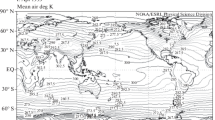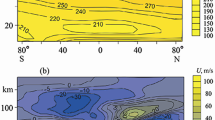Abstract
This is a study of the sensitivity of model results (atmospheric content of main gas constituents and radiative characteristics of the atmosphere) to errors in emissions of a number of atmospheric gaseous pollutants. Groups of the model variables most dependent on these errors are selected. Two variants of emissions are considered: one without their evolution and the other with their variation according to the IPCC scenario. The estimates are made on the basis of standard statistical methods for the results obtained with the detailed onedimensional radiative—photochemical model of the Main Geophysical Observatory (MGO). Some approaches to such estimations with models of higher complexity and to the solution of the inverse problem (i.e., the estimation of the necessary accuracy of external model parameters for obtaining the given accuracy of model results) are outlined.
Similar content being viewed by others
References
Climatic Change 2001. The Scientific Basis. Contribution of Working Group I to the Third Assessment Report of the Intergovernmental Panel on Climate Change, Ed. by J. T. Houghton, Y. Ding, D. J. Griggs, et al. (Cambridge Univ. Press, Cambridge, 2001).
Scientific Assessment of Ozone Depletion: 2002, WMO Global Ozone Research and Monitoring Project Report No. 47 (Geneva, 2003).
H. von Storch and F. Zwiers, Statistical Analysis in Climate Research (Cambridge Univ. Press, Cambridge, 2001).
I. L. Karol’ and A. A. Kiselev, “Assessment of the Effect of Accuracy in the Rates of Photochemical Reactions on the Calculation of the Contents of Minor Gases in the Atmosphere,” Izv. Akad. Nauk SSSR, Fiz. Atmos. Okeana 24, 663–666 (1988).
A. M. Thompson and R. W. Stewart, “Effect of Chemical Kinetics Uncertainties on Calculated Constituents in a Tropospheric Photochemical Model,” J. Geophys. Res. D 96, 13 089–13 108 (1991).
D. Gao, W. R. Stockwell, and J. B. Milford, “First-Order Sensitivity and Uncertainty Analysis for a Regional-Scale Gas-Phase Chemical Mechanism,” J. Geophys. Res. D 100, 23 153–23 166 (1995).
D. J. Fish and M. R. Burton, “The Effect of Uncertainties in Kinetic and Photochemical Data on Model Prediction of Stratospheric Ozone Depletion,” J. Geophys. Res. D 102, 25 537–25 542 (1997).
D. B. Considine, R. S. Stolarski, S. M. Hollandsworth, et al., “A Monte Carlo Uncertainty Analysis of Trend Predictions in a Two-Dimensional Model,” J. Geophys. Res. D 104, 1749–1765 (1999).
I. Karol, A. Kiselev, V. Zubov, T. Egorova, et al., “An Assessment of the Statistical Significance of the Total Ozone Changes Simulated with Global Chemical Transport Model MEZON,” Geophys. Res. Lett. 31, L20108, doi: 10.1029/2004GL020536 (2004).
N. G. Andronova and M. E. Schlesinger, “Objective Estimation of the Probability Density Function for Climate Sensitivity,” J. Geophys. Res. 106, 22605–22612 (2001).
Radiative-Photochemical Models of the Atmosphere, Ed. by I. L. Karol’ (Gidrometeoizdat, Leningrad, 1986) [in Russian].
Climate Change-Radiative Forcing on Climate Change and an Evaluation of the Intergovernmental Panel on Climate Change IS92 Emission Scenarios, Ed. by J. T. Houghton, G. Meira Filho, J. Bruce, et al. (Cambridge Univ. Press, London, 1994).
A. A. Kiselev and I. L. Karol, “Modeling of the Long-Term Tropospheric Trends of Hydroxyl Radical for the Northern Hemisphere,” Atmos. Environ. 34, 5271–5282 (2000).
A. A. Kiselev and I. L. Karol, “The Ratio between Nitrogen Oxides and Carbon Monoxide Total Emissions As Precursors of Tropospheric Hydroxyl Content Evolution,” Atmos. Environ. 36, 5971–5981 (2002).
Atmospheric Chemistry and Global Change, Ed. by G. P. Brasseur, J. J. Orlando, and G. S. Tyndall (Oxford Univ. Press, Oxford, 1999).
Climate Monitoring and Diagnostics Laboratory Summary Report No. 26, 2000–2001 NOAA (Boulder, 2002).
Climate Monitoring and Diagnostics Laboratory Summary Report No. 27, 2002–2003, NOAA (Boulder, 2004).
E. L. Aleksandrov, Yu. A. Izrael’, I. L. Karol’, and A. Kh. Khrgian, Ozone Shield of the Earth and Its Changes (Gidrometeoizdat, St. Petersburg, 1992) [in Russian].
Author information
Authors and Affiliations
Corresponding author
Additional information
Original Russian Text © V.A. Frol’kis, I.L. Karol’, A.A. Kiselev, Yu E. Ozolin, V.A. Zubov, 2007, published in Izvestiya AN. Fizika Atmosfery i Okeana, 2007, Vol. 43, No. 4, pp. 453–462.
Rights and permissions
About this article
Cite this article
Frol’kis, V.A., Karol’, I.L., Kiselev, A.A. et al. Statistical analysis of a global photochemical model of the atmosphere. Izv. Atmos. Ocean. Phys. 43, 413–422 (2007). https://doi.org/10.1134/S0001433807040032
Received:
Issue Date:
DOI: https://doi.org/10.1134/S0001433807040032




